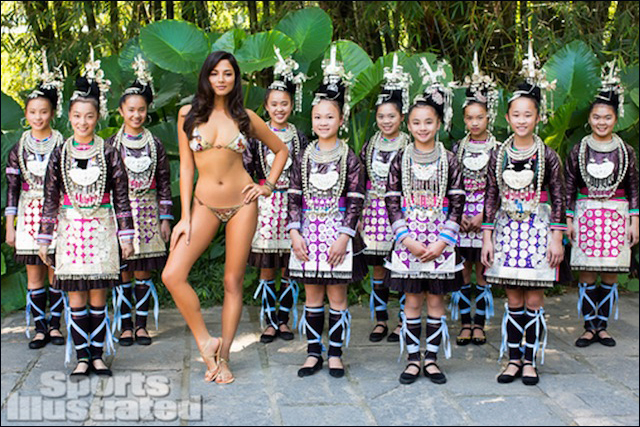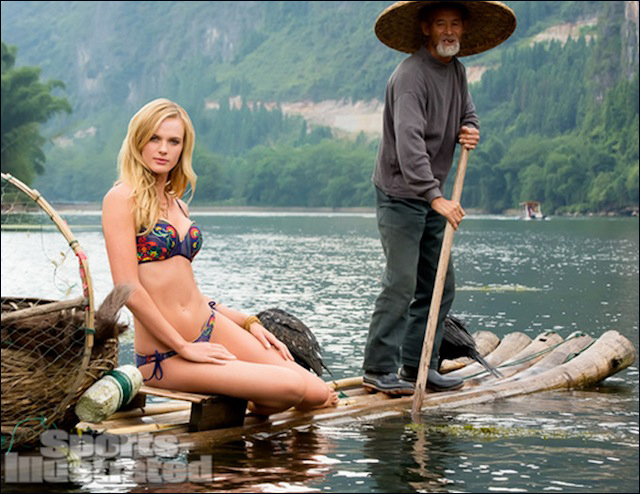
Note: this post contains images which may not be desirable to view at work… at least without having to explaining yourself out of some awkward moments.
Earlier this past month, Sports Illustrated released its 2013 edition of its popular “Swimsuit Issue”. This issue is, as far as I know, this magazine’s only influential “contribution” to American pop culture. I mean, who’s even seen any other issues of Sports Illustrated these days? Does anyone even have a Sports Illustrated subscription, anymore? It’s like people claiming they read Playboy for the articles.
According to Wikipedia, Sports Illustrated — started in the 1950’s — was once America’s most prominent and influential sports magazines. Credited with both popularizing many sports and many athletes over the decades, as well as liberal use of colour photographs in the magazine media, Sports Illustrated set out to legitimize itself as the premiere magazine for sports enthusiasts.
It’s interesting to note, therefore, that the magazine’s Swimsuit Issue, which was first published 14 years after Sports Illustrated‘s founding, was intended to fill space in an otherwise slow winter issue of the magazine when few sports were being played. The magazine’s editor requested that a then-unknown photographer conscript some aspiring models and take pictures of them in bikinis in exotic locales to fill a five-page spread and the cover. Since that time, the swimsuit issue has come to define Sports Illustrated, and has helped launch the careers of many supermodels. Yet, the irony of the swimsuit issue is that, even in its conception, the feature was never expected to have anything to do with athleticism. It was intended merely as a ploy to sell magazines, not focus on athletes or the sports they play in any way. Over the years, the swimsuit edition has evolved into what it unabashedly remains today: cheap regressive exploitation of (White) sexuality imperialistically juxtaposed against exotic locales in a seedy effort to sell more magazines.
And, the tragedy of the swimsuit edition is that it works: in 2005, it generated $35 million dollars in advertising sales alone.
Last week, several feminist and Asian American blogs including Jezebel, Shanghaiist, and Angry Asian Man wrote about Sports Illustrated‘s latest swimsuit edition, citing its use of Asian and African people and cultures as ethnic props. And indeed, the magazine’s usage of clearly ethnic signifiers to underscore the “exoticism” of each model’s environment is clearly offensive.

In these photos, locals are not treated as human; instead they are ethnic and cultural scenery, no more human than the hat they are wearing or the boat they are poling around on the river.
But, I also have to express some frustration that of all the problems inherent in the Sports Illustrated swimsuit issue, that the blogosphere has chosen to focuse largely on the few images (that I could find) of people of colour (and frequently Asia people) being used as ethnic props, and have spoken largely on the problem therein. No mention is made of the more widespread Orientalism inherent in these images and their design, wherein the same blonde model pictured above is also dressed in a chi pao-inspired one piece and stood up in front of a curtain with Chinese writing on it to evoke a sense of the wild, sensual East. True, no Asian person is being used as an ethnic prop in these images, but that doesn’t make them any less Orientalist.

The very nature of these photoshoots is that they are (and have been since their conception) nothing more than an annual cultural safari that feeds upon the West’s fetishism for the foreign and the exotic.
Moreoever, while one can express clear anger towards the dehumanization and Otherization of the Chinese fisherman above as an ethnic prop, I would argue that that the models, themselves, are also no more humanized than their backdrops (human or otherwise). The visual juxtaposition that Sports Illustrated hopes to achieve through their swimsuit issue is one of culture clash: a “hot girl-next-door” meets “exotic locale”, all designed to tantalize and titillate. In that pursuit, it’s no surprise that just as Chinese fishermen, coolie hats, and feathers are used to signify the exotic and the Other, the swimsuit models themselves — and specifically their race, ethnicity, and overall aesthetic — are signifiers of the familiar (and specifically the West). It’s no surprise therefore that of the 21 models featured in this year’s swimsuit edition, no more than three are non-White or Hispanic. In fact, most are blonde or brunette Caucasian women, and all (regardless of race) share the same facial features and body-type typical of Eurocentric ideals of beauty.
Thus, these female models, too, are dehumanized props: of Whiteness, of femininity, of sexuality. These women are not presented in these photographs as intellectual and nuanced individuals, but as objects to evoke the reader’s sexual desire. They exist in these pages to entice the (implicitly male and implicitly heterosexual) reader, to be looked at and longed for. In short, it’s soft-core porn, pure and simple.

In short, there is no one in these photos who is humanized by the camera’s lens: neither the half-naked woman ostensibly “modeling” a swimsuit (whatever that has to do with sports) nor the Chinese fisherman standing behind her (whatever that has to do with sports). Everything about these photoshoots is about putting women and non-White people subservient to the sexuality of the White male reader of Sports Illustrated.
So yes, I’m outraged by the use of Asian people as ethnic props. But, I’m also outraged by the use of women as sexual props. And, most of all, I’m outraged that in 2013, Sports Illustrated is still managing to sell itself as a reputable and legitimate magazine when one month out of the year it’s about as racially and sexually progressive as Maxim.

